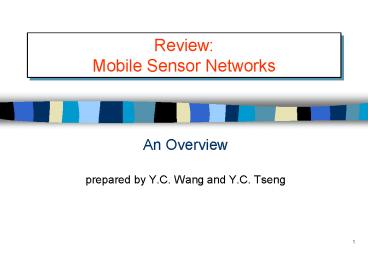Review: Mobile Sensor Networks - PowerPoint PPT Presentation
Title:
Review: Mobile Sensor Networks
Description:
Mobile Sensor Networks An Overview prepared by Y.C. Wang and Y.C. Tseng Introduction As sensors become widely deployed, some sensors may be enhanced with mobility. – PowerPoint PPT presentation
Number of Views:76
Avg rating:3.0/5.0
Title: Review: Mobile Sensor Networks
1
ReviewMobile Sensor Networks
- An Overview
- prepared by Y.C. Wang and Y.C. Tseng
2
Introduction
- As sensors become widely deployed, some sensors
may be enhanced with mobility. - Such mobile sensors may be more powerful and can
re-charge themselves automatically. - An important application is in the robot area.
- Why need mobile sensors?
- Resilient to failures
- Reactive to events
- Support disparate missions
3
Research Directions on Mobile Sensor Networks
- Improve network topology
- WSN deployment
- WSN fault diagnosis
- Enhance sensing in WSN
- Enhance routing in WSN
- Applications
4
Improve Network Topology (1/2)
- Make a stronger network
- P. Basu and J. Redi, Movement control algorithms
for realization of fault-tolerant ad hoc robot
networks, IEEE Network, vol. 18, no. 4, pp.
3644, 2004. - Find out cut-vertices and move sensors around to
make the network biconnected.
5
Improve Network Topology (2/2)
- Enhancing an existing WSN
- S. Zhou, M. Y. Wu, and W. Shu, Finding optimal
placements for mobile sensors wireless sensor
network topology adjustment, in IEEE Circuits
and Systems Symposium on Emerging Technologies
Frontiers of Mobile and Wireless Communication,
2004, pp. 529532. - Randomly drop sensors may not guarantee a
connected network - Add mobile sensors to connect separated
components
Static sensors
6
WSN deployment (1/3)
- Virtual force
- Y. Zou and K. Chakrabarty, Sensor deployment and
target localization based on virtual forces, in
IEEE INFOCOM, 2003, pp. 12931303. - A sensor si will be exerted by three kinds of
forces - An attractive force by the deployed area
- A repulsive force by all obstacles
- A force by another sensor sj (is expressed
by polar coordinate notation )
moving direction of S1
wA/wR measure of the attractive/repulsive
force dth a threshold distance
7
WSN deployment (2/3)
- Voronoi diagram
- G.Wang, G. Cao, and T. L. Porta,
Movement-assisted sensor deployment, in IEEE
INFOCOM, 2004, pp. 24692479. - Use Voronoi diagram to find potential coverage
holes and move sensors to cover these holes
Voronoi diagram
Node v is farthest to the vertex u, so it moves
in that direction.
8
WSN deployment (3/3)
- Grid structure
- G. Wang, G. Cao, T. L. Porta, and W. Zhang,
Sensor relocation in mobile sensor networks, in
IEEE INFOCOM, 2005, pp. 23022312. - Grid-quorum
- A high-density grid sends Advertisements along
its row - A low-density grid sends Requests along its
column - Cascaded movement
- A direct (long) movement can be decomposed into
multiple (short) movements. This can achieve
better fairness.
9
WSN Diagnosis
- Bidding Protocol
- G. Wang, G. Cao, and T. L. Porta, A Bidding
Protocol for Deploying Mobile Sensors, in IEEE
Intl Conf. on Network Protocols, 2003, pp.
315324. - Static sensors estimate coverage holes, and then
use hole sizes to compete for mobile sensors to
move in.
10
Enhance Sensity of WSN
- Event-based motion
- Z. Butler and D. Rus, Event-based motion control
for mobile-sensor networks, IEEE Pervasive
Computing, vol. 2, no. 4, pp. 3442, 2003. - Move more sensors closer to the event locations
while still maintaining complete coverage of the
field
(1) Initial topology of the network
(2) Determine event locations
(3) Move sensors around so that event areas have
higher sensor density. Complete coverage is
maintained.
11
Enhance routing in WSN
- Mobile relay
- W. Wang, V. Srinivasan, and K. C. Chua, Using
Mobile Relays to Prolong the Lifetime of Wireless
Sensor Networks, in Mobicom, 2005, pp. 270-283. - Use mobile relay to extend the lifetime for the
bottleneck nodes. - Example sensors A and B are rotated in routing
packets.
12
Applications
- Pursuer-evader problem
- C. Sharp, S. Schaffert, A. Woo, N. Sastry, C.
Karlof, S. Sastry, and D. Culler,Design and
implementation of a sensor network system for
vehicle tracking and autonomous interception, in
European Workshop on Sensor Networks, 2005, pp.
93107. - The evader will randomly move in the sensing
field - The pursuer can capture the evader by the
information from the static WSN































